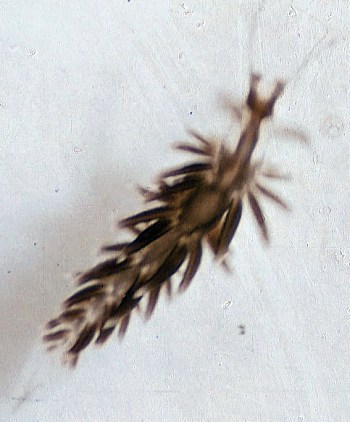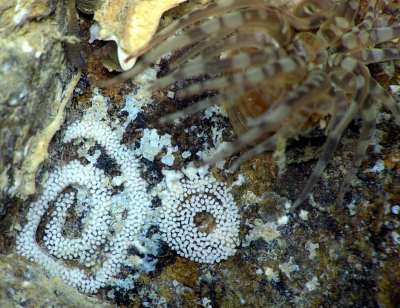
Herviella mietta
Marcus & Burch, 1965
Order: NUDIBRANCHIA
Suborder: AEOLIDINA
Family: Glaucidae
DISTRIBUTION
Eniwetak Atoll, Marshall Ids & Hawaii. New record on Forum from Japan.
PHOTO
Photo of specimen from type series from Eniwetak Atoll. Photo by J.B. Burch, sent to Bill Rudman by Eveline Marcus.
The original description mentions two colour types. "The first is light and transparent, the back covered in white granules, the head has a black pattern, there is a black band on the rhinophores, some black pigment on the (oral) tentacles, and the yellow diverticula of the intestinal gland may seen in the cerata (which also have white cnidosacs and, in their basal third, brown pigment). The second color type is dark, and the back and upper part of the sides of the foot are black, the rest of the foot and the sole are white, the tentacles have a narrow black longitudinal stripe, there is a black band on the rhinophores, there are light haloes around the eyes and between the tentacles, and the cerata are black, with a white cnidosac and the yellow intestinal gland showing though".
According to Burn (1967) the holotype is a black specimen [2nd colour type] as in the accompanying photo). Young (1967) reports further specimens from Eniwetak and makes the interesting observation that the larvae pass the veliger stage in the egg capsule, hatching as crawling young after 6 days. Egg capsules are deposited on the substrate and on the shells of the snail Cerithium sejunctum. Herviella mietta was observed eating the eggs of Cerithium sejunctum and Young suggests this is a seasonal occurrence and hypothesises that their normal food is a hydroid. Gosliner (1979) reports H. mietta and records it feeding on the anemone Anthopleura nigrescens. He also notes that Rosin's (1969) earlier extensive observations of Herviella sp. feeding on the column of Anthopleura refer to this species. If the identification is correct, this is the only record I can recall of a glaucid feeding on a sea anemone.
References:
• Burn, R F (1967) Revision of the genus Herviella (Opisthobranchia: Eolidacea). Malacologia, 6(1-2): 223-230.
• Gosliner, T.M. (1979) The systematics of the Aeolidiacea (Nudibranchia: Mollusca) of the Hawaiian Islands, with descriptions of two new species. Pacific Science, 33(1): 37-77.
• Marcus, Er., & Burch, J.B. (1965) Marine euthyneuran Gastropoda from Eniwetok Atoll, western Pacific. Malacologia, 3(2): 235-262.
• Rosin,R (1969) Escape response of the Sea Anemone Anthopleura nigrescens (Verrill) to its predatory aeolid nudibranch, Herviella Baba sp. nov. The Veliger, 12(1): 74-77.
• Young, D.K. (1967) New records of Nudibranchia from the Central and West-Central Pacific with a description of a new species. The Veliger, 10: 159-173.
Rudman, W.B., 2001 (May 27) Herviella mietta Marcus & Burch, 1965. [In] Sea Slug Forum. Australian Museum, Sydney. Available from http://www.seaslugforum.net/find/hervmiet
Related messages
Re: Herviella mietta? from Japan.
December 24, 2003
From: Jun Imamoto


Dear Bill.
Thank you for valuable comment. Here is a photo taken in the same neighborhood as where the sea slug was observed. It shows an egg mass and one of the sea anemone's i mentioned in my earlier message. I suspect the egg mass belongs to Herviella mietta. There were many egg masses and anemones, but I'm afraid I have no direct evidence that the egg masses were made by Herviella mietta, but I thinnk it is probable that it would lay its eggs near its food. I will continue my investigation of Herviella mietta.
Date: 18 Dec 2003
Amami, Ooshima Islands, Kagoshima, Japan.
size: about 4-7mm (The diameter of the egg mass)
depth: 0.5 m
temperature: 22 C
Best Regards,
Jun Imamoto
imamoto@umiushi.info
Imamoto, J., 2003 (Dec 24) Re: Herviella mietta? from Japan.. [Message in] Sea Slug Forum. Australian Museum, Sydney. Available from http://www.seaslugforum.net/find/11728Thanks Jun,
Thanks for this interesting addition. As I mention on the Fact Sheet, Young reported that this species has a form of direct development where the veliger larvae develops in the egg capsule and then metamorphoses into a crawling slug within the egg capsule. The eggs in your mystery egg ribbons are quite large so they could well be thoes of a direct developer. I look forward to future instalments of information.
Best wishes
Bill Rudman
Herviella mietta? from Japan.
December 22, 2003
From: Jun Imamoto


Dear Bill.
This sea slug, Herviella mietta doesn't seem to be reported on the Forum from Japan, so here is a Japanese individual. It was discovered under a stone in shallow water in a sheltered bay.
There were many sea anemones in the neighborhood. I am very interested about the distribution of Herviella mietta. I am happy if these reports are useful for your research.
18 December 2003
place: Amami Ooshima Islands, Kagoshima, Japan.
size about: 12mm
depth: 0.5 m
temperature: 22 C
Best Regards,
Jun Imamoto
http://www.umiushi.info/
imamoto@umiushi.info
Imamoto, J., 2003 (Dec 22) Herviella mietta? from Japan.. [Message in] Sea Slug Forum. Australian Museum, Sydney. Available from http://www.seaslugforum.net/find/11720
Dear Jun,
Yes I am sure this is Herviella mietta. As far as I know the only records we have of it are from Enewetak Atoll in the Marshall Ids and from the Hawaiian Ids, so your find in Japan is an interesting extension to its known distribution. I am also interested in your description of it being in an area with many sea anemones. As I discuss in the Fact Sheet, there are possible observations of it in Hawaii feeding on a sea anemone, which is of interest because aeolids of the family Glaucidae are not known to feed on sea anemones. So if you get a chance to observe this species again it might be worth 'introducing' it to an anemone and seeing if it takes any interest. There is not much chance it will start feeding, but it is always worth a try.
Best wishes
Bill Rudman
